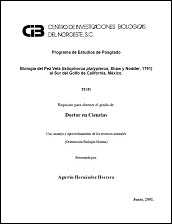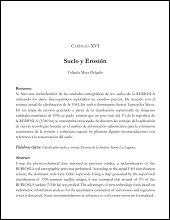Alimentación de la escifomedusa Stomolophus meleagris en la laguna costera Las Guásimas, noroeste de México
Alimentación de la escifomedusa Stomolophus meleagris en la laguna costera Las Guásimas, noroeste de México
Autor
JESUS GUADALUPE PADILLA SERRATO
JUANA LOPEZ MARTINEZ
ALEJANDRO ACEVEDO CERVANTES
EDGAR ALCANTARA RAZO
CARLOS HIRAM RABAGO QUIROZ
Metadatos
Mostrar el registro completo del ítemResumen
"La medusa “bola de cañón” (S. meleagris), ha alcanzado altos niveles de producción en la laguna costera de Las Guá-
simas, Sonora, en el noroeste de México, lo que la ha llevado a ser un recurso pesquero importante; no obstante, se
desconoce su importancia y papel ecológico en el ecosistema. Este trabajo describe la alimentación de esta especie,
con el fin de conocer su importancia trófica en esta laguna costera. Se capturaron 17 organismos en cada una de tres
campañas realizadas (marzo, 2008, febrero y abril, 2009); se les extrajeron los estómagos y se analizaron para determinar
la composición de su dieta. Se utilizaron los métodos cuantitativos de frecuencia de ocurrencia (F), numérico (N),
gravimétrico (P) y el índice de importancia relativa (IIR) para determinar la composición de la dieta. Para estimar la
amplitud de la dieta, se usó el índice de Levin. Se identificaron 13 tipos de presas, todas pertenecientes a la comunidad
del zooplancton; los huevos de anchoa fueron el tipo de presa más importante. Los resultados mostraron que S. mele-
agris es un depredador especialista (con una preferencia marcada por un tipo de presa), con un nivel trófico terciario
(3.2), lo que permite clasificarla como un consumidor secundario." "The cannonball jellyfish (S. meleagris) has reached production levels that has led it to become an important fishery
resource in Las Guásimas, Sonora, a coastal lagoon in northwestern Mexico; however, its ecological importance and
role in the ecosystem remain unstudied. This contribution describes the diet composition of this species in order to
reveal its trophic importance in this coastal lagoon. Up to 17 jellyfish were captured in each of three surveys (March
2008, February and April 2009), their stomachs were extracted and analyzed to determine their diet composition. The
quantitative methods: frequency of occurrence (F), numeric (N), gravimetric (W) and the index of relative importance,
were used to measure the diet components, and Levin´s index to measure the diet amplitude. Thirteen preys were identified;
all belonging to the zooplankton community; the most important prey were the anchovy eggs. Our results show
that S. meleagris is a specialist predator (with a marked preference for certain prey), classified in the third trophic level
(3.2), as a secondary consumer."
Colecciones
Ítems relacionados
Mostrando ítems relacionados por Título, autor o materia.
-
PROMOCIÓN DEL PERIFITON PARA EL CULTIVO DE CAMARÓN BLANCO: HACIA UNA ACUICULTURA ECOLÓGICA
DOMENICO VOLTOLINA LOBINA; JUAN MANUEL AUDELO NARANJO; MARIA DEL ROSARIO PACHECO MARGES -
Suelo y Erosión
YOLANDA LOURDES MAYA DELGADO


